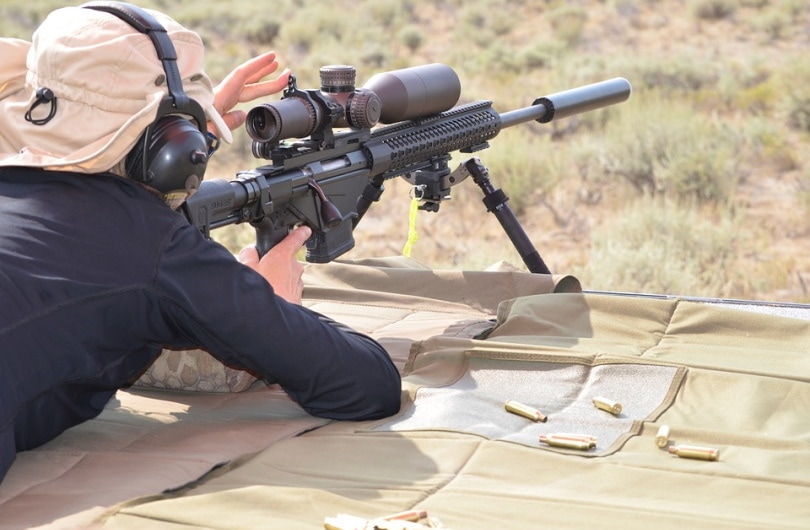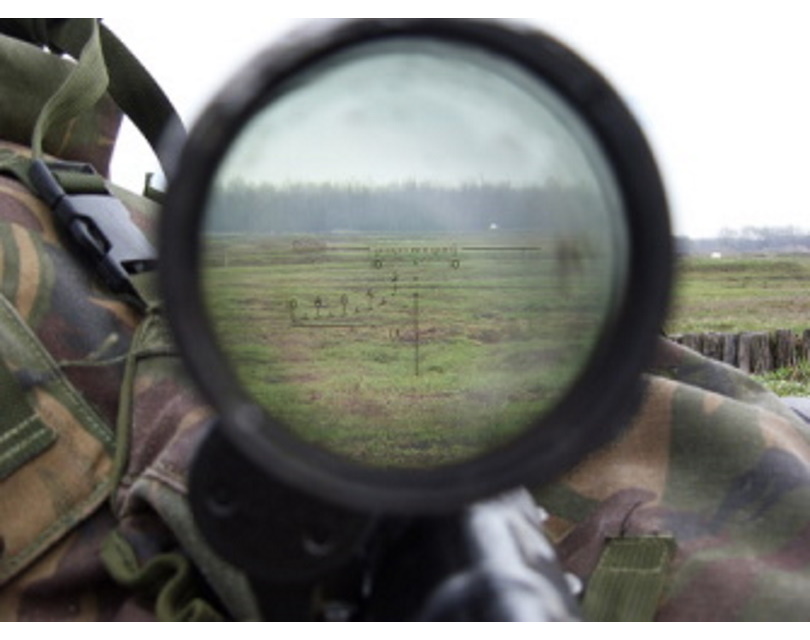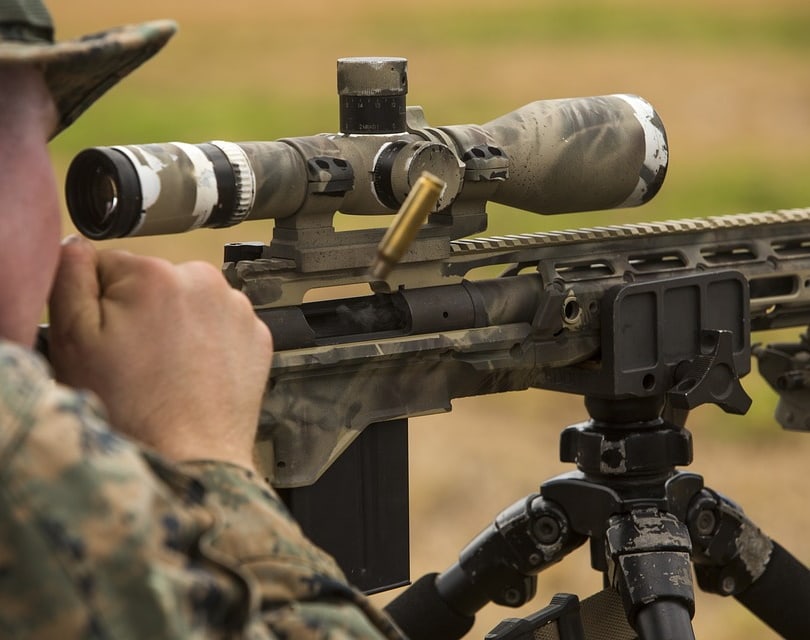How to Sight in a Rifle Scope Without a Boresighter
Last Updated on

While using new technology to zero in your scope is all the rage, it doesn’t beat sighting your scope in the old-fashioned way. Not only is it more complicated to use a device like a boresighter, but unless you also have a great understanding of the physics behind your rifle and rounds, it’s not nearly as effective!
In this guide, we walk you through everything you need to know to sight in your rifle scope without having to purchase anything extra or use a boresighter. When you’ve finished sighting your scope, your bullets will be hitting the bullseye every time you pull the trigger!

Why You Need to Sight in Your Scope
When everything is working correctly on your scope, the crosshairs line up with where the bullet will go when you pull the trigger. But this is not an amazing coincidence — it happens when you sight in your rifle scope.

While you can sight in your scope to a variety of distances, we recommend starting with 100 yards, as this is the most versatile and what most rifles and scopes work best with. Once you have a better understanding of what you’re doing, you can see in your scope for different distances if you need to.
Why should you cite in your scope? So you can hit your target, of course!
What Is a Boresighter?

While we’re going to walk you through how to sight in your rifle scope without a boresighter, it’s still a good idea to know what a boresighter is, so if anyone brings it up, you know what they’re talking about.
A boresighter is a laser-pointer device that fits into the muzzle of your rifle. When you turn the boresighter on, it sends a laser pointer out to your target, and you can adjust your scope accordingly.
While this might sound easy, what it fails to account for is bullet drop. Bullet drop varies by your specific rifle and the types of rounds that you’re shooting, so it can be hard to calculate this without firing a shot. While bullet drop might not seem like a big deal, it can lead to significant misses.
At 100 yards, most rounds will drop anywhere from 2″ to 4″, which might not sound like much. But when you run that number out to 500 yards, it can easily stretch into the 30″ to 50″ range. Instead of hitting your target, it’s going to fall a few feet short. When you sight in a scope without a boresighter, you can factor in bullet drop.
Before You Start

Before you head out to the range, make sure you have everything that you need. You’re going to need a target, proper hearing protection, and your rifle with the scope already mounted. Finally, make sure you have any tools that you might need in order to make adjustments. This will vary based on your specific scope, so take your time and get acquainted before you head out.
How to Sight in A Rifle Scope Without a Boresighter
Sighting in your scope without a boresighter is easier than you think. In fact, it’s the easiest way to accurately sight in your scope!
Set Up Your Range
When you’re sighting in your scope, you want to set your target out for 100 yards. From there, make sure that you’re using the same rounds that you’ll be firing when you’re shooting for real. Otherwise, your results are going to vary a bit.
Set Up Your Rifle and Scope

While you should already have your scope mounted, you still need to make the necessary windage and elevation adjustments before you start firing. This is a crucial step, and if you skip it, your scope won’t be sighted correctly, and you’ll end up missing a ton of shots.
You want to do everything just like you would if you were aiming down your sights on a deer or a target and you weren’t sighting your scope.
Establish Your Grouping

Once you set everything up, line up your scope with the target and take your shot. You’re not likely to bullseye the target here, and that’s okay. What you want to do is line up the scope with the bullseye every time and pull the trigger, even if the round isn’t going where you want it to.
Take three to five shots, then head out to take a look at your target. Hopefully, all the rounds are in the same area on the target. If not, you probably need to work on your technique a bit more.
Measure and Adjust
If you take a look at your target and all the holes are together, you’re in good shape, and you can start making your adjustments! All you need to do is measure the average distance from the bullseye to the group and make the adjustments based on that. Measure both the horizontal and vertical distances to the bullseye.
Wash, Rinse, and Repeat
Once you’ve made your adjustments, head back to the shooting position and take your next set of shots. Get your rounds in a cluster, and once that cluster is around the bullseye, you can stop making adjustments! You’ve successfully zeroed in your scope without any fancy tools, and you’ll now get better results!

Once You’re Done
Once you’ve sighted in your scope, it should hold zero, even if you don’t fire it for weeks or months. If your scope isn’t holding zero, it’s indicative of a few potential problems, including a faulty scope or if you’ve attached it to a weapon with too much recoil for it.
But if you have the right scope on the right weapon and don’t mess with the adjustments again, you won’t have to worry about it coming out of zero no matter what you do!
Hopefully, this guide has walked you through everything you need to know about sighting in your scope. Now you can head out to the range or field and know that your round is going to go exactly where you want it to!
You might also be interested in:
Featured Image Credit: shepardhumphries, Pixabay
About the Author Robert Sparks
Robert’s obsession with all things optical started early in life, when his optician father would bring home prototypes for Robert to play with. Nowadays, Robert is dedicated to helping others find the right optics for their needs. His hobbies include astronomy, astrophysics, and model building. Originally from Newark, NJ, he resides in Santa Fe, New Mexico, where the nighttime skies are filled with glittering stars.
Related Articles:
How to Clean a Refractor Telescope: Step-by-Step Guide
How to Clean a Telescope Eyepiece: Step-by-Step Guide
How to Clean a Rifle Scope: 8 Expert Tips
Monocular vs Telescope: Differences Explained (With Pictures)
What Is a Monocular Used For? 8 Common Functions
How to Clean a Telescope Mirror: 8 Expert Tips
Brightfield vs Phase Contrast Microscopy: The Differences Explained
SkyCamHD Drone Review: Pros, Cons, FAQ, & Verdict
